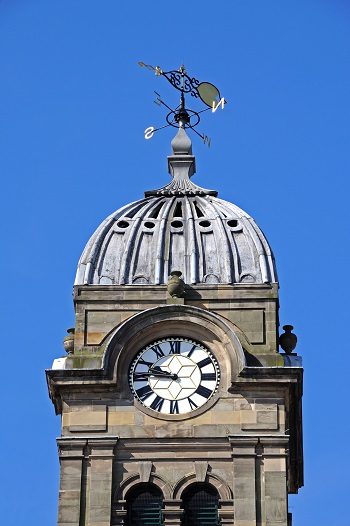 Once a rural settlement rich in natural resources, the city of Derby has successfully transformed itself into a thriving manufacturing and business centre favoured by large multinationals and individual entrepreneurs alike. Over the past few decades, Derby has managed to retain its competitive edge, and as a result, it has been listed as one of the top 20 most sustainable cities in the United Kingdom. In order to achieve this status, Derby has had to adapt itself to a changing social and economic environment. In turn, this has prompted the development of various regeneration schemes that aim to make the city more livable and appealing. As part of our urban regeneration series, this article takes a detailed look at Derby’s regeneration plan and at how it has boosted the local economy in this East Midlands city.
Once a rural settlement rich in natural resources, the city of Derby has successfully transformed itself into a thriving manufacturing and business centre favoured by large multinationals and individual entrepreneurs alike. Over the past few decades, Derby has managed to retain its competitive edge, and as a result, it has been listed as one of the top 20 most sustainable cities in the United Kingdom. In order to achieve this status, Derby has had to adapt itself to a changing social and economic environment. In turn, this has prompted the development of various regeneration schemes that aim to make the city more livable and appealing. As part of our urban regeneration series, this article takes a detailed look at Derby’s regeneration plan and at how it has boosted the local economy in this East Midlands city.
Derby’s Cityscape Masterplan
Derby’s Cityscape Masterplan is an ongoing project that outlines a framework for the regeneration of the city centre. Initially, the plan focussed on attracting businesses and investment to the area, and allocated a budget of £2 billion to several regeneration projects that were to be carried out around the city centre area. The Cityscape masterplan has been clearly successful, as it has already had far-reaching economic repercussions. For example, during the implementation of phase one of this urban regeneration plan Derby rose to the top of the UK’s fastest growing cities in terms of GVA.
The city’s masterplan included the development of the £340-million Westfield shopping centre, which has created 3,000 new jobs since 2007 and which attracts more than 25 million shoppers every year. In December 2013, Derby’s City Council announced its plans to invest £1 million in the regeneration of St Peter’s Quarter, a shopping area located in the city centre that will be given a full makeover in order to make in safer and more inviting. The Council has also granted planning permission for the development of Friar Gate Square, a 10,000-square metre site that will target retail and office occupiers.
Derby’s Cityscape plan also took into account the decreasing availability of Grade A office space in the city centre. In 2010, the city council called out to private investors and created a £10 million fund to encourage the development of commercial offices in the city centre. To date, the Cityscape masterplan has added 1.4 million square feet of office floorspace to Derby’s total commercial stock.
Improving living standards in Derby
Derby’s Cityscape masterplan not only aimed to make the city more attractive to business owners and investors, but also hoped to make it a more liveable place for current and future residents. To achieve this, the city’s regeneration plan included the construction of various new housing developments in the city centre, focussing on delivering affordable and high-quality housing along Stuart Street and the surrounding area.
Although not strictly part of the Cityscape masterplan, the development of Castleward Urban Village is a project worth mentioning, as it will also contribute to enhancing Derby’s quality of life and sustainability standards. This project involves the regeneration of a 12-hectare brownfield, which will be transformed into a mixed-use commercial and residential development. Upon completion, Castleward will add 34,500 square feet of prime commercial floorspace to the city and will provide 800 new homes conveniently located between the train station and the city centre.
Successful Sustainable City
Sustainable cities are characterised by their open spaces. To improve the quality of life of Derby’s residents, the Cityscape project planned for the transformation of a problematic area known for attracting offenders and anti-social behaviour. More than £100 million were invested in the total transformation of Cathedral Green, which is now a welcoming and safe public space whose prime location has also attracted the attention of business owners, resulting in the creation of the business complex at Number One Cathedral Green.
The city’s masterplan has also put a considerable amount of work into improving Derby’s cultural scene. The development of the Quad Centre has significantly broadened the cultural and leisure offer in Derby. The project had a total cost of £11.2 million. Along the same lines, the regeneration plan contemplated the restoration of the facilities at Derby College Engineering and Technology Campus. This project cost £36 million and helped enhance Derby’s reputation as a centre for educational excellence.
Lastly, the masterplan included a new public transport strategy that began with the transformation of Derby’s bus station, which now features state-of-the-art facilities and numerous shopping outlets. Nearby, the Riverlights complex was developed to accommodate a large hotel and commercial premises.
Thanks to Derby’s Cityscape masterplan, the East Midlands city will continue to attract investors, creating new jobs and making Derby a better city in which to live and work. If you are considering a move to or expansion in Derby please view our currently available office space.
Sources:
http://www.transformingcities.co.uk/transforming-derby
http://www.derbytelegraph.co.uk/Plans-regeneration-Derby-s-St-Peter-s-Cross/story-20299263-detail/story.html
http://www.building4change.com/article.jsp?id=2165#.U_jQyP7Ztu4
http://www.bbc.co.uk/news/uk-england-derbyshire-11820704
If you have any updates on the Derby regeneration plan please let us know via the comments below or email us at office @ primeofficespace dot co uk.

